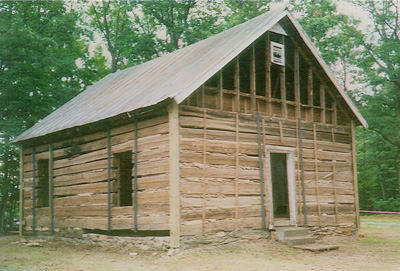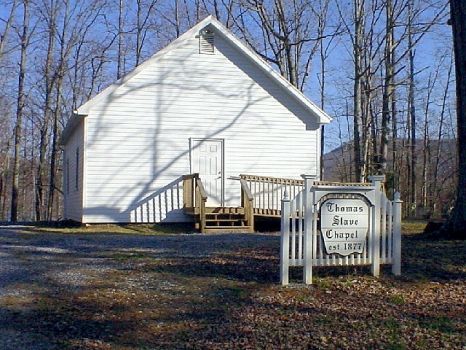Thomas Slave Chapel - Virginia
 The African American Heritage Preservation Foundation, Inc. became involved with the Thomas Slave Chapel in 1996, when it was asked by the Virginia Department of Historic Resources to assist in finding historical information on the Chapel located in Huddleston, Bedford County, Virginia and to assist the Friends of the Thomas Slave Chapel in obtaining a historic highway marker commemorating the Chapel. At the time, the Thomas Slave Chapel was thought to be one of the few known surviving chapels from the antebellum period that remained intact and retained much of its integrity.
The African American Heritage Preservation Foundation, Inc. became involved with the Thomas Slave Chapel in 1996, when it was asked by the Virginia Department of Historic Resources to assist in finding historical information on the Chapel located in Huddleston, Bedford County, Virginia and to assist the Friends of the Thomas Slave Chapel in obtaining a historic highway marker commemorating the Chapel. At the time, the Thomas Slave Chapel was thought to be one of the few known surviving chapels from the antebellum period that remained intact and retained much of its integrity.
Preservation Services Fund
On July 23, 1998, the Foundation was awarded a $2,500 grant from Partners for Sacred Places and The National Trust for Historic Preservation to develop a Structural Plan for the Thomas Slave Chapel located in Bedford County, Virginia (c. 1850, National Register-eligible).
Save America's Treasures - 2000
 The African American Heritage Preservation Foundation, Inc. nominated the Thomas Slave Chapel in Bedford County, Virginia, to the "Save America's Treasures" listing in addition to seeking financial support for the restoration and cultural landscaping of the Chapel's surrounding area. This Chapel was considered an endangered site as a result of recent rezoning (R-1).
The African American Heritage Preservation Foundation, Inc. nominated the Thomas Slave Chapel in Bedford County, Virginia, to the "Save America's Treasures" listing in addition to seeking financial support for the restoration and cultural landscaping of the Chapel's surrounding area. This Chapel was considered an endangered site as a result of recent rezoning (R-1).
On June 21, 2000, the National Trust for Historic Preservation designated the Thomas Slave Chapel as one of its Official Projects under the Save America's Treasures program.
Save America's Treasures is a public private partnership between White House Millennium Council and the National Trust for Historic Preservation, which is dedicated to the preservation of our nation's irreplaceable historic and cultural treasures for future generations.
Rehabilitation of the Thomas Slave Chapel
In 2002, the Friends of the Thomas Slave Chapel completed the rehabilitation of the Chapel. However, the historic significance of the property greatly depended on a definitive 19th-century construction date for the Chapel. A more thorough architectural investigation of the log structure was required.
Dendrochronology Study
The only remaining avenue to properly date this structure is dendrochronology, a traditional technique for establishing the absolute date of events. This technique would only benefit the historic Thomas Slave Chapel and support its significance as well as provide another method for historians and researchers to investigate and glean vast knowledge from African American culture and history.
With financial support from the National Trust for Historic Preservation, the dendrochronology study of the Thomas Slave Chapel was conducted by the principal investigator, Herman J. Heikkenen, Ph.D in 2003. The study found that the timbers used to construct the Chapel were hewed and sawed from trees felled after the growing seasons of 1875 and 1876 and not during the antebellum period.
The final report of the dendrochronology study.
Given this new data, it is possible that the congregation was established during the antebellum period, hence the name, Thomas Slave Chapel; however, no documentation has been found to date to substantiate this.
Today, the Thomas Slave Chapel is used for special events and its annual Family and Friends Day, which is held every fourth Sunday in August.
The African American Heritage Preservation Foundation has partnered with several public and private sector entities throughout the past twenty-nine years. Our Preservation Partners have not only provided cooperative agreements and preservation grants, but also human capital - architects, educational staff, historians, preservationists, local leaders, college students and volunteers.